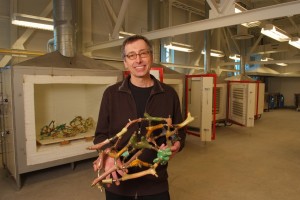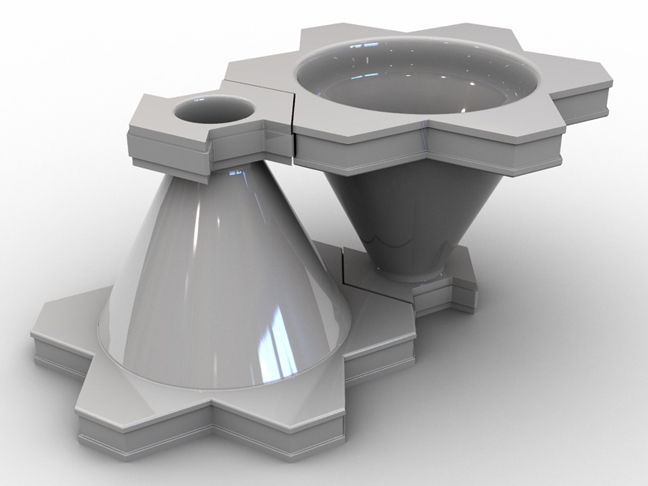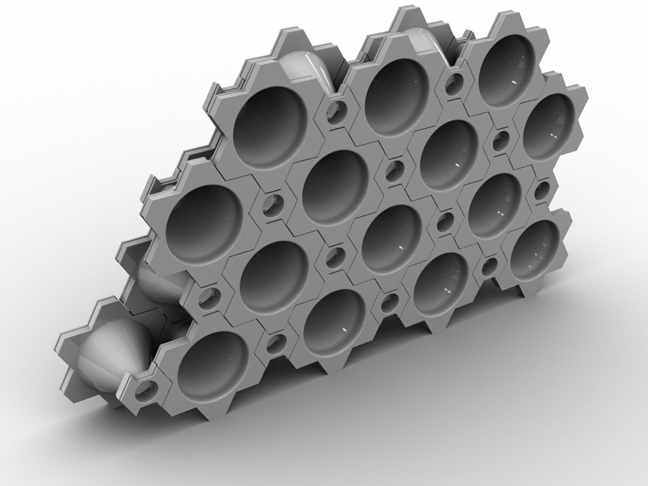NSCAD University
an overview of departments using digital modeling
ZCorp Zprinter 310
Rhino software, JewelCAD
Vacuform & various plastics forming equipment
RAM press

new Blaauw gas & electric kilns
NSCAD University has recently acquired the ZCorp 310 printer that sits in a new Plastics Lab, and will be shared by all departments.
For the Ceramics Department, a particular interest is integrating rapid prototyping into our ceramic ‘Process & Design’ course, which relates mold/production techniques to ‘boutique design’. Further, we wish to connect rapid prototyping to the making of models for our 60-ton RAM press. Current buddhism and on-line dating experiments include 2-part starch and ABS molds for the making of silicone and urethane rubber models, which are then used to cast ‘male’ parts in RAM die molds. We are beginning to experiment with various output media, hard to flexible.
Given the close relationship of NSCAD’s Ceramics Department to the Dalhousie University School of Architecture speed dating in maryland in Halifax, the first architectural object underway is small connector unit to construct interior screens and scrims.
NSCAD Ceramics is cultivating relationships with several research-oriented architects to exploit ceramics properties in scenarios for sustainable design. I am a consultant on Philip Beesley’s SSHRC (Social Sciences and Research Council, Canada) grant entitled ‘Responsive Architectures’, which investigates a sculptural vision of architectural surfaces composed of interlocking matrixes of various natures (conducted through the Architecture program at the University of Waterloo, Ontario). See http://www.philipbeesleyarchitect.com/
NSCAD Jewellery Department has been the college pioneer in 3D visualization software with the use homer web cam of JewelCAD and Rhino as part of coursework. Rapid prototyping and lost wax casting is used to produce CAD creations, with some outside CNC milling. Until the arrival of our ZCorp printer, Jewellery students have shipped files to private companies that print jewelry prototypes for them. The achievement of fine detail remains a question for jewelers and specific RP equipment.
In sarah 26 nyc interracial dating our Product Design Department, a recent addition to NSCAD’s Design Division, faculty member Glen Hougan has begun experimenting with ZCorp prints in thematic work on health and aging issues. First prints were non-working models of asthma atomizers.
In a separate federally funded research initiative, NSCAD colleague Robin Muller has acquired a Dimension Printer (outputting ABS plastic), for exclusive use on a ‘Smart Textiles’ initiative. Electronic fabric is interwoven with lights, sensors and actuators to be responsive to sound, movement, sunlight and touch. These prototypes are developments in curtains, free standing walls, theatrical backdrops, and hung wildcat12788 dating photo profile ceilings for tensile roofs.
NSCAD University has committed to supporting faculty in research partnerships outside the institution (see http://www.nscad.ns.ca/research/research_centres.php). This is a innovative direction for a ‘stand alone’ art school, which we hope will create unique opportunities for faculty and students, which may allow for new kinds of research or project-based MFA studies in the future.


 The Acoustic Wall is a project of precision cast ceramics to form an interlocking partition wall. The proposition is to dampen interior sound with hard and glossy material.
The Acoustic Wall is a project of precision cast ceramics to form an interlocking partition wall. The proposition is to dampen interior sound with hard and glossy material.

